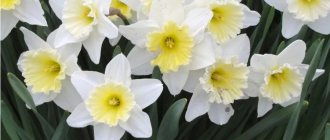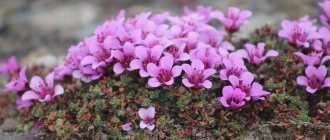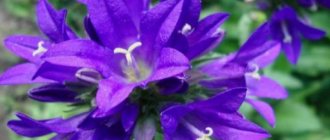Canna is an ornamental perennial that belongs to the family Cannaceae. The first flowers were exported from India, China, South and Central America. It was brought to the European continent by Portuguese ships in the 16th century. The ancient Greek designation can be translated as “reed”, the Latin - “pipe”. An ancient Indian legend tells that the leader of one of the tribes decided to burn the peace treaty in a fire, and a bloody massacre broke out. At the site of the fire, flowers with bloody petals grew, reminiscent of flashes of flame or spilled blood.
Description of the canna flower
The branched rhizomes of the perennial plant spread widely to the sides. Thickened hollow stems from 0.6 to 3 m end in a peduncle. Large leaves in the form of an ellipse or elongated shape have a length from 25 to 80 cm, a width from 10 to 30 cm at the top, sharp, with a smooth surface. The inflorescences and foliage are decorative. The green mass comes in attractive colors, ranging from malachite, maroon, red-brown to lilac.
The inflorescences of the plant, collected in a panicle or brush, are distinguished by a variety of colors. Bloody, golden, soft pink, amber, speckled, bordered, asymmetrical, they resemble a gladiolus or an orchid. Upon fertilization, a three-locular capsule appears.
Varieties of cannas
Almost all modern varieties are descended from the Indian species of canna. The cultivated descendants are given the botanical designation Canna hortum.
| View | general description | Height, m | Varieties |
| Crozy | Appeared in 1861. The leaves are malachite or dark burgundy with white. The petals are bent. | 0,6-1,6 |
|
| Orchids | Flowers up to 12.5-17.5 cm in diameter, edges in the form of folds. Dark green or lilac-green tone of leaves. | 1-2 |
|
| Deciduous (Small-flowered) | The leaf is malachite, lilac or green-green in color. The flowers are small, up to 6 cm in diameter. | 3 | Durban: Orange-yellow flowers, striped green leaves. |
Late-blooming canna varieties
The advantage of late varieties is longer flowering. Although they bloom buds only in the middle of summer, they decorate the garden until the October (and even November) frosts.
Among the late cannas worthy of competing with autumn dahlias, it is worth noting the following varieties:
Canna Picasso

The height of the bush is quite modest, no more than 90 cm, but the main advantage of the variety is its large tiger-colored inflorescences. Their diameter reaches 13 cm. Large and thick red specks are scattered on a bright yellow background. The leaves are large, wide and green, with a lighter or darker shade. Picasso blooms only in mid-summer. But you can admire the tiger buds until October.
Thanks to its compact size, the variety can be grown not only in open ground, but also as a potted crop.
Kanna Lucifer

A very impressive two-color variety with compact dimensions. The bush grows to a maximum of 80 cm in height. The leaf blade is green, wide, with wavy edges. The photo of Canna Lucifer shows that its flowers are bright red, with a wide and uneven yellow border. The height of the inflorescence reaches 12 cm, and the canna blooms from mid-summer until frost.
If you transplant the canna from the garden into a pot in the fall and take it into the house, it will bloom almost all year round. And it will grow well in a pond.
The compact plants, about 50 cm tall, are often sold under the name Canna Dwarf Lucifer. In general, these are the same variety, just of a different “caliber”. The coloring is also the same, the only thing is that the width of the border can be wider or narrower.
Read also: Description of the most popular types of Kalanchoe
Canna Yellow Humbert
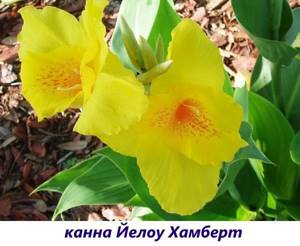
A medium-sized plant, it rarely grows more than 120 cm. The green leaves are large and wide. Closer to the tip they taper, ending in a sharp apex. The flowers are also medium in size, up to 10 cm high. This is a very beautiful yellow canna. Its petals are lemon yellow. A thick red speck is drawn in the center of the inflorescence. Sometimes it can partially transfer to the petals.
Kanna Semaphore
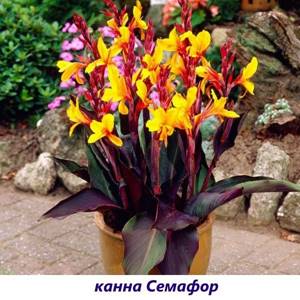
A very spectacular variety with a height of 90 to 180 cm. Notable for the contrasting color of leaves and buds. Against the background of brown foliage with a purple tint, yellow traffic lights of neat small flowers burn brightly. Flowering lasts from July to September. This is one of those species that feel good both in a flowerbed and in a tub indoors.
The variety tolerates short-term drought well, but not during the growing season.
Kanna Black Knight
The variety is characterized by good resistance to adverse weather conditions, which do not affect its development and flowering.
Kanna Gnome
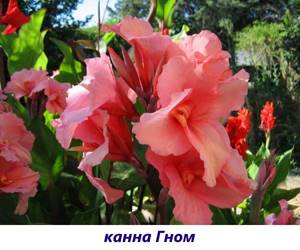
Canna Gnome is called dwarf - the height of the plant is only 50 cm. Its delicate inflorescences are charming: for a canna itself, they are quite large, painted pink. The center of the flower barely noticeably casts a sunny yellow tint. The buds are formed on short stalks, but the leaves of the Gnome are large, oval in shape, with sharp tips. The foliage is the usual green color. Canna blooms from July to October.
Canna Cleopatra
- half of the petals are scarlet;
- the rest is yellow with red speckles.
These are not all varieties and types of cannas, and there are many more plants that can be grown in the garden or in tubs. Don’t put off your dream until “later” and don’t be afraid to buy these wonderful flowers. May they bloom and delight you for many years to come!
Video about the best varieties of cannas
The genus includes 50 species of cannas that grow in South America, China and India. A perennial plant with a tuberous rhizome. Canna has erect, unbranched stems. The foliage is large, oval-oblong, green, purple-bronze or striped.
The flowers are orange, yellow, red, pink of various shades or white, large, odorless, on short stalks, which are collected in terminal paniculate or racemose inflorescences.
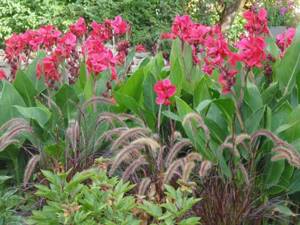
Canna is a deciduous ornamental plant with dense foliage and brightly colored flowers. Based on the color of their leaves, cannas are divided into red-leaved, green-leaved and striped. There are varieties with black-purple and dark purple foliage. There are varieties of cannas bred only for the beauty of their foliage.
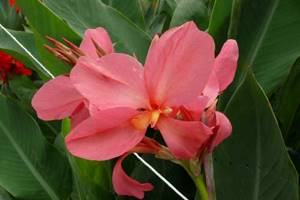
The canna flowers themselves are in shades of pink, red and yellow. Flowering depends entirely on the preparation of the plant. In optimal conditions, plants bloom immediately after planting in open ground and bloom from July until frost.
Growing canna in the garden
The flowers are unpretentious and can be successfully grown in the garden and in public places. Reproduction is carried out by dividing the tubers and by sowing seeds.
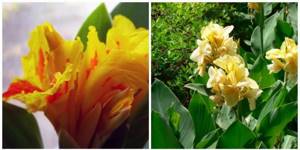
Crozy
Sowing canna seeds
Typically, plants were cultivated using this method for breeding purposes. Canna seeds of easily germinating varieties for garden plots appeared quite recently, but quickly gained popularity.
Seeds begin to germinate in late January-early February. The durable shell does not allow the flower to germinate quickly.
To speed up the process, they help it collapse. It is recommended to use one of the methods:
- treated with boiling water;
- keep for 3-4 hours in a thermos with hot water;
- bury it in a snowdrift for 2-3 hours or put it on the freezer shelf for 1 hour;
- act mechanically.
After this treatment, the seeds are placed in an aqueous solution of a growth stimulator for 24 hours. The prepared seeds are placed in bowls with planting soil to a depth of 0.7-1 cm, after watering they are covered with film and removed for germination, which lasts for a month. At this time, conditions are created in the soil so that its temperature remains at +22 ºC. After 3-4 leaves grow, the seedlings are transferred to separate containers. Flowers develop in them before being transplanted outside. After 3-4 days, the picked seedlings are kept in a room with a temperature of +16...+18 ºC.
Growing from rhizomes
Dividing the rhizome is a reliable way to propagate cannas. It begins in the last ten days of March - the first days of April. The roots, stored in the cellar over the winter, are cleaned and the dried parts are separated. Each is cut into sections, focusing on the number of buds on the tuber. Those who are close do not share.
To prevent infection by fungal diseases, the resulting sections are treated with potassium permanganate (0.2 g per 1 liter of water) or wood ash.
The prepared cuttings are planted in the ground, consisting of equal parts of soil, peat chips and rotted manure. You shouldn't go deep. Germination of the first leaves should be expected in 2-3 weeks. As they appear, the pots are moved to well-lit rooms, where they will be at a temperature of +16...+18 ºC. Under the created conditions, new shoots do not stretch and develop in time. Minor watering and keeping the temperature down is all the care young seedlings need.
Planting canna and subsequent care (propagation by seeds and rhizomes)
Propagation by seeds and rhizomes is allowed, which can be divided in the autumn after the flowering process is completed. Sowing seeds should be done as early as possible; the best period is late January early February.
Before sowing, canna seeds must be thoroughly rubbed with sandpaper to partially destroy the durable protective shell. Without this measure, germination may deteriorate, and the emergence of seedlings may be delayed for up to 4 months.
After sawing, the seeds are soaked for a day in a nutrient solution of growth stimulants. Then sowing is done in the prepared nutrient soil. Any soil for indoor plants is suitable for these purposes.
The container with the sown seeds should be placed in a warm place. Only at temperatures above 25 degrees Celsius can you wait for seedlings.
Planting canna by dividing the rhizome is the easiest and most reliable way to propagate the crop in a personal plot.
The seed method is more recommended for breeding work, since seedlings may not retain species and varietal qualities. Sometimes you get very interesting fantasy combinations of colors in the petals of the buds.
With proper sowing, seedlings can appear after 4 weeks. In the phase of 2 true leaves, planting is carried out in separate containers for seedlings (picking).
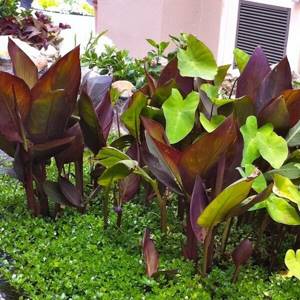
Propagation by rhizome is a fairly simple method. To do this, an inspection of overwintered rhizomes is carried out in March. It is divided according to the principle - so that 1 flower bud remains on each segment.
The sections are treated with wood ash or crushed activated carbon and dried. After this, all the rhizomes are placed in a container and covered with calcined sand.
Watering is carried out every other day. The container is covered with plastic wrap and placed in a bright place.
Ideal conditions arise on the windowsill, which faces the south or east side of the house and under which the heating radiator is located. In this case, the leaves will appear quite quickly (after 2 weeks).
After this, the canna is planted in separate pots with nutritious soil.
Germinating canna tubers is a mandatory procedure in our difficult climatic conditions. This is the only way to get abundant and long-lasting flowering. It is not worth planting unsprouted tubers, as they will not have time to produce buds.
Planting canna on a personal plot in open ground is carried out no earlier than May 20. By this time, the threat of return frosts on the soil should have passed. Already grown plants with a stem height of up to 80 cm are planted.
Before planting, prepare suitable soil. A high degree of soil fertility is required - compost or humus and complex mineral fertilizer are added.
When planting and subsequently caring for cannas, experienced gardeners use various agrotechnical tricks. Thus, a “warm” pillow gives the optimal result.” To equip it, a trench is dug and the entire layer of soil is removed from the ridge.
A thick layer of hay or fresh manure is placed at the bottom. Then the earth is poured back. Due to the biochemical processes taking place in the hay layer, a constant flow of heat to the canna root system is ensured. The plant blooms 2 weeks earlier.
The planting depth of the rhizome is up to 15 cm. Do not cover the growing point on the stem. Subsequent care of plants consists of regular watering. Once every 10 days, you should add a few grains of manganese to the watering can when watering. This stimulates flowering.
Fertilizing is carried out using the root method. Preparation of a solution for fertilizing: for 10 liters of water, take 20 ml of organic complex fertilizer “Ideal” and 1 tbsp. a spoonful of the mineral additive “Agri-Cola” for flowers. Everything is thoroughly dissolved. 10 liters of solution is enough to water 10 plants.
When to plant cannas
Cannas are transferred to open ground after the end of return frosts. Damaged roots can take a long time to germinate, development lags behind, delaying flowering, and possibly its complete absence.

Deciduous
Soil selection
Planting flowers requires a sunny place, protected from drafts and wind. Canna loves humus-enriched, warm soils. The garden space is prepared in advance. To do this, dig a hole with a diameter of 0.5-0.6 m. The bottom is filled with fresh manure 0.2 m high. Due to it, the rhizome will become warmer, the flower will actively develop and bloom well. Soil is poured on top of the manure. The rhizome is placed in the spilled hole, with the growth point facing upward, and sprinkled with earth. The planting depth of unsprouted rhizomes is no more than 6-9 cm. A distance of 0.5 m is maintained between plants, and 0.3 m between dwarf varieties. The same is maintained between rows in the case of a large number of seedlings. Mulching the planted flowers allows you to protect the plantings from lack of moisture and weed germination. After planting, it takes 2 weeks for sprouts to appear; 1.5-2 months pass before flowering. At temperatures below +15 ºC, the emergence of seedlings is delayed.
Then the flowers require timely watering, loosening of the top layers of soil and fertilizing.
Canna breeding
By seeds and division of rhizomes.
At the beginning of October, the cannas are taken out, with a lump of earth and transferred to a cool room.
In March, cannas need to be shaken off the ground, old roots cut off and divided into small shoots of rhizomes.
To awaken growth, the separated rhizomes must be laid out in a greenhouse and carefully sprayed with warm water, preventing rotting. In April, the canna rhizomes must be transferred to a greenhouse, where they must be laid close to each other and sprinkled with earth on top.
Read also: Features of growing indoor vines with photos and names
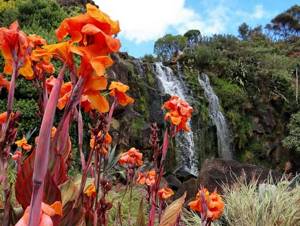
When the canna foliage begins to crowd each other, the cannas are removed from the ground and planted in 13 cm pots. Before planting in open ground, plants are cultivated in deep greenhouses. By June, prepared seedlings already produce flower shoots.
The places where the rhizomes are cut should be sprinkled with coal and dried a little. By the time of planting in open ground, the plants have time to develop 7-8 large leaves.
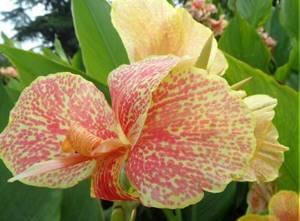
Species cannas are propagated by seeds. Seedlings of varietal cannas give a slight deviation from the original species. Canna seeds need scarification. Shoots appear in a month.
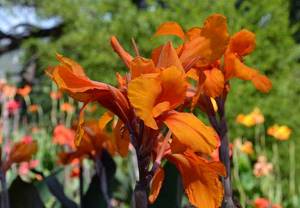
How to fertilize cannas
Throughout the growing period, cannas are given additional feeding for timely development. Along with watering, add 2 g of potassium permanganate to a bucket of water (or place granules under each plant). This stimulates the start of flowering. Before flowering, nutrition is applied in the form of a solution of chicken manure and water in a ratio of 1:10. A similar watering is repeated after 2 weeks. Cannas love complex mineral fertilizers sprinkled under each bush. They are mixed with the soil at the time of loosening.
When watering, you need to monitor the amount of water. Excess may create the possibility of an outbreak of fungal diseases.
At the end of the season, the root collars are sprinkled with soil to avoid damage with the onset of cold weather. During the first frosts, pruning is done by 15-20 cm. Digging at the end of September is carried out with a large lump of soil.
Plant care
Cannas accept good care with gratitude, like any other plant. In order for cannas to bloom on time and look impressive, they need to be promptly rid of weeds and loosen the soil around the bushes. During the entire flowering period, it is necessary to remove dried inflorescences.
Watering cannas before the flowers appear should be moderate, but during flowering this flower requires abundant watering. Closer to autumn, watering should be reduced and finally stopped after the cannas have flowered. Cannes delight the eye with their bright colors from August until mid-autumn. After this, the roots of the plants need to be insulated by dense hilling in case of sudden frosts. For the winter, the roots are dug up along with a lump of earth around the root and stored in boxes until spring.

Canna root system
Some gardeners grow cannas in pots and keep them indoors in the winter, and plant them in open ground in the spring. This flower is absolutely not afraid of transplantation, and if frost is already close, and the cannas continue to actively bloom, transplant them into a pot. These beautiful flowers will delight you until December.
Storing canna in winter
At the end of August, the cannas are transplanted into containers, which can be easily brought indoors if there is a threat of frost. The final digging is carried out in the last days of September or the first days of October; the flowers are not frost-resistant. To improve the wintering of cannes, it is important to create an air temperature of +7…+15 ºC. She has no noticeable rest period.
The plant pleases the gardener with its beauty all year round. However, in order for the flowers to enter the blooming stage, it needs to create conditions. For 2 months, cannas are stored in a cool place with little lighting, while reducing watering. After digging, storage is carried out in perlite, sphagnum moss or peat, poured into plastic boxes, at a temperature of +6...+8 ºC. They try to avoid touching the tubers. Twice a month the condition of the rhizomes is checked, if necessary, wetting the materials with which they are covered with water. The damage is removed and the cut area is treated with iodine.
Cannes storage
How to preserve these magnificent plants in winter? In September, flowering bushes should be hilled high to prevent the roots from freezing in the event of frost. After the first frost, when the leaves wither, the bushes are cut 10–15 cm from the soil surface and carefully dug out with a pitchfork. The earth is not shaken off from the roots. The rhizomes are placed in boxes, dried for 1–2 days and covered with a sand-peat mixture. It is best to store roots at a temperature of +5 +8ºС. During the winter, the tubers should be periodically inspected and rotten areas should be cut out. The cut areas are treated with brilliant green or iodine. A small amount of roots can be stored well in the refrigerator, wrapped in paper.
Cannes have always been widely used in urban landscaping. They were planted in flower beds of city parks and squares, in the Alexander Garden and in other significant and visited places. They are the ones who create solemnity and brightness, exotic beauty. At the same time, they are unpretentious and drought-resistant. They are practically not affected by pests and are not susceptible to diseases. They have only one drawback - they do not winter in open ground. But the beauty and exoticism are worth putting up with. Everything else is pure merit! Anyone who has not planted cannas in their garden will never be able to understand the feelings and emotions that you experience when you see such wonderful plants. Plant, admire and admire this truly worthy flower.
Canna at home
Cannas are grown independently or transplanted in the fall from a flower garden into a flowerpot with a diameter of at least 50 cm. To avoid infection of domestic plants, the ground is treated with insecticides in advance. In winter, the flower becomes a bright corner that attracts the eye. To thrive, it requires a lighted place and timely watering. The leaves of the plant are gently wiped several times. After flowering it needs rest. Cut the stem to a height of 10-15 cm and put it in a shady place with a temperature of +10 ºC.
Let's say a few words about common varieties
Well, now let’s say a few words about what varieties and varieties exist. Canna flowers have been favorites of breeders for several centuries. Therefore, the existence of many varietal varieties is quite understandable. Let's talk only about the most striking of them, since a complete catalog can take a hundred pages of text and no less number of pictures.
Orchid cannas are similar in their inflorescences to catleya. Their stems reach a height of up to 2.5 meters. The buds are simply huge, they reach 20 cm in diameter. And the leaves corrugated along the edges complement the unusualness and fantastic nature of the picture.
You should not pass by deciduous varieties that do not have such outstanding buds, but their deciduous mass will give a head start to any even very beautiful flowering plants. The height of the variety reaches 3 meters. This amazing property allows them to effectively decorate the fence line and delimit the landscape design of the site. The Durban variety provides the opportunity to use unusual striped leaves in creating a composition for any backyard garden.
Read also: 10 useful indoor plants with photos and descriptions
Look at the varieties of canna flowers in the photo, the magnificent splendor of their flowering is shown:

Problems when growing cannas
The flower plant is susceptible to diseases and various types of pests.
| Disease/pest | Symptoms | Corrective measures |
| Viral diseases | Yellow stripes develop along the veins and on the leaf. Then faded spots appear, plant development is delayed, and flowering is delayed. | There is no cure. Plants should be dug up and destroyed. |
| Fungal diseases: rust and gray mold | Orange spots all over the plant. Brown spots on the flower. | Adjust the humidity of the soil and surrounding air. Increase circulation. Adjust temperature. Spray the leaves: ¼ teaspoon of chlorothalonil per 1 liter of water. Repeat the procedure after 10 days. |
| Phytoplasma disease | The leaves turn yellow, wrinkle, and grow deformed. | Destroy the diseased plant. |
| Leaf rollers | The appearance of holes in leaves eaten by insects | Set traps or collect by hand. |
| Spider mite | Yellow thickenings on the leaves. | Treat with horticultural oil, insecticidal soap or solution. Periodically pick off the old lower leaves. Reduce watering and nitrogen fertilization. |
| Thrips | Clear or yellow spots. |
Mr. Summer Resident recommends: canna in the landscape
Cannas are good both in group plantings and planted individually, which is why they are loved by landscape designers. It is good to plant against the background of low-growing plants: marigolds, coleus, cineraria. Combine with kochia, perilla and petunia.
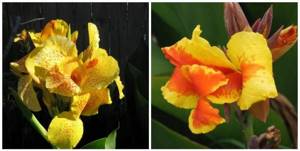
Orchids
When planting with other flowers, provide a central position by placing medium-sized and low flowers around. When planted in groups, they are placed in the form of wide and long ridges.
Summer balconies, loggias and terraces are decorated with flowers, planted in a flowerpot or large tub.



